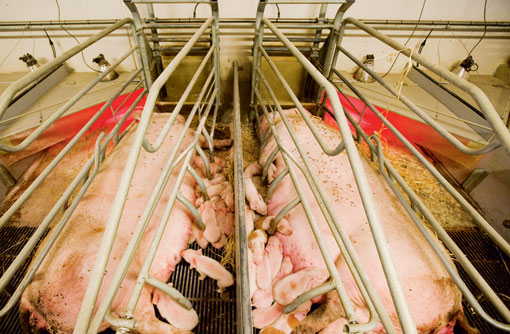Danish genetics raises pig performance in NI

Increasing numbers of pig producers are using Danish genetics in Northern Ireland, with the aim of producing pigs with higher daily liveweight gains, bigger litters and high lean-meat percentage.
Derek Warke manages a 1,200 sow unit for Malcolm Keys at Clogher, near Omagh in County Tyrone and began using Danish (DanBred) semen two years ago.
The business operates a Landrace nucleus within a herd of PIC-bred stock and in 2011 these sows were served with DanBred semen. The DanBred breeding programme uses performance, fertility and carcass traits as selection criteria.
“Through AI we are now creating a purebred nucleus Large White herd of Danish sows, which are a hardier type of sow. They are more suited to slatted systems and we are serving these back to Landrace,” Mr Warke explains.
He took the approach of using AI instead of buying breeding stock because he wanted to maintain the high health status of the closed herd. He admits he would have had more rapid results if he had used breeding stock.
“It does take longer to get results through AI, but we were nervous about bringing in new stock. We will breed up over the next couple of years,” he says.
The Danish approach
Mr Warke has visited pig units in Denmark and could see benefits of following the Danish approach. “Everything we were doing on our unit was as good as the Danish, but they were turning out 30-plus pigs weaned a year from each sow. The only point of difference was they were using Danish genetics,” he says.
At that time his units were producing 27.5 pigs weaned a sow a year and he believed using Danish genotypes would help lift productivity. “We thought Danish genetics would help us to push performance up a notch or two,” added Mr Warke.
Results
The first of the Danish halfbred gilts farrowed in early 2012 and the first Danish-bred third-parity sows have now started to farrow.
Mr Warke has already seen an improvement in his results as a result of the Danish-bred influence. In 2011 gilts produced an average of 11.8 piglets born alive a litter and that figure has now increased to 13.
The second-parity sows are now producing 14.4 born alive. Mr Warke is confident he will hit his target of 30 pigs weaned a sow a year within 18 months.
In addition to the increase in litter numbers, there have been other benefits, including a marked improvement in growth rates.
Mr Warke has been using a Danish terminal line on the sows and is pleased with the results. The Danish Duroc, the only terminal sire used in Denmark, is renowned for its high-quality carcass and eating qualities.
“They are doing the business; they are very fast-growing. Our unit is producing growth rates up to 1kg a day between 35kg and 110kg liveweight, which is an improvement of 110g a day on what we had been achieving previously,” says Mr Warke.
On average, Danish herds produce 500kg more pig meat a sow a year than herds in the UK. The genotypes used are credited with playing an important role in optimising productivity, performance and carcass quality.
The Malcolm Keys units finish pigs at 85kg deadweight and supply Sainsbury’s and Tesco through abattoirs in Northern Ireland.
Royalty payments
There is a cost to using Danish genetics – there are royalties to pay – but Mr Warke says this is a price worth paying. “This approach will be cost effective if we are going to improve performance and that certainly is the target.
“Our business is a numbers game. If we can get better performance – and that definitely is our goal – then there are benefits to be had from improved genetics. We are sure we will get more pigs out the door and a better finisher performance.”
Mark Hawe, pig adviser to the Department of Agriculture in Northern Ireland, says the use of maternal-line genetics from a number of sources is, without doubt, influencing improvements in sow performance.
Detailed unit performance, that has been gathered over a 30-month period involving more than 15,000 commercial sows, has shown numbers of pig weaned a sow a year has increased by almost two pigs.
“A lot of this is down to improved numbers born alive in gilts and sows,” Dr Hawe comments. “In addition, pre-weaning mortality has only increased slightly, indicating not only are there more live-born piglets, but they are hardy viable piglets too.”

